Estimating the Performance Loss Rate of Photovoltaic Systems Using Time Series Change Point Analysis
Abstract
1. Introduction
2. Materials and Methods
2.1. Experimental Setup and Data Acquisition
2.2. Data Processing and Creation of PV Datasets
2.3. PLR Estimation Using Statistical Methods
- (1)
- Each change point corresponds to two data segments (e.g., one segment from the start month of the reporting period to the corresponding month of the change point, and the other from the change point month to the end month of the time series) with supposedly different means. In case of more than one change point, the number of segments is equal to the number of change points plus one (number of segments = number of change points + 1).
- (2)
- For each change point, we subtract the data of its second segment from the data of its first segment (i.e., the data difference, xd) and ensure that the months of the subtracted data correspond. If the detected change point is not statistically significant, then the mean of xd should be statistically zero. Otherwise, if the mean of xd is not statistically zero, then the detected change point is statistically significant.
- (3)
- We test the following hypothesis (assuming that the differences xd,i are random from normal distribution such as the E (xd,i) = 0):
- Null hypothesis H0: E (xd,i) = 0
- Alternative hypothesis Hα: Ε(xd,i) 0
2.4. Validation through Indoor Testing and Synthetic Dataset
3. Results and Discussion
3.1. Linear PLR Estimates Using the LOESS Technique
3.2. Nonlinear PLR Estimates Using CP Algorithms
3.3. Indoor Testing Results and Validation
3.4. Summary and Future Directions
- The LOESS trend can be used for an initial screening to detect obvious change points within the PV performance time series.
- The application of change point algorithms proved to be an efficient statistical technique for detecting nonlinear power loss in PV systems.
- The identified change points may be attributed to failures/defects, maintenance events and/or actual degradation mechanisms. Suggestions for future research include the development of a detailed methodology for attributing the reason (e.g., maintenance events, fault, and degradation modes) behind the detected change points.
- Different numbers and locations of change points were detected based on the applied algorithm. This reveals the method dependency of the PLR estimation.
- The indoor testing validation revealed invisible defects that may be the root cause of PV’s low performance and the existence of change points.
- The validation of the FBP model on the created PV performance time series with data anomalies showed its capability for capturing trend changes, even in the presence of anomalous conditions. Though, further investigation and validation on data with different types of outliers, such as global (i.e., point anomalies), contextual (i.e., conditional anomalies), and collective outliers, is needed to verify the above statement.
4. Conclusions
Author Contributions
Funding
Data Availability Statement
Acknowledgments
Conflicts of Interest
Abbreviations
| a-Si | Amorphous silicon |
| ARIMA | Autoregressive integrated moving average |
| Beast | Bayesian estimation of abrupt change, seasonality, and trend |
| Bkp | Breakpoints |
| CdTe | Cadmium telluride |
| CP | Change point |
| CSD | Classical seasonal decomposition |
| CIGS | Copper indium gallium diselenide |
| EL | Electroluminescence |
| FBP | Facebook prophet |
| HW | Holt–Winters |
| IR | Infrared |
| IEC | International Electrotechnical Commission |
| LCOE | Levelized cost of energy |
| LOESS | Locally weighted scatterplot smoothing |
| mono-c Si | Mono-crystalline silicon |
| multi-c Si | Multi-crystalline silicon |
| OLS | Ordinary least squares |
| OTF | Outdoor test facility |
| PLR | Performance loss rate |
| PR | Performance ratio |
| PV | Photovoltaic |
| PCA | Principal component analysis |
| PELT | Pruned exact linear time |
| STC | Standard test conditions |
| UCY | University of Cyprus |
References
- Theristis, M.; Livera, A.; Jones, C.B.; Makrides, G.; Georghiou, G.E.; Stein, J.S. Nonlinear Photovoltaic Degradation Rates: Modeling and Comparison Against Conventional Methods. IEEE J. Photovolt. 2020, 10, 1112–1118. [Google Scholar] [CrossRef]
- Phinikarides, A.; Kindyni, N.; Makrides, G.; Georghiou, G.E. Review of Photovoltaic Degradation Rate Methodologies. Renew. Sustain. Energy Rev. 2014, 40, 143–152. [Google Scholar] [CrossRef]
- Phinikarides, A.; Makrides, G.; Georghiou, G.E. Estimation of Annual Performance Loss Rates of Grid-Connected Photovoltaic Systems Using Time Series Analysis and Validation through Indoor Testing at Standard Test Conditions. In Proceedings of the 2015 IEEE 42nd Photovoltaic Specialist Conference, New Orleans, LA, USA, 14–19 June 2015; pp. 1–5. [Google Scholar] [CrossRef]
- Jordan, D.C.; Deceglie, M.G.; Kurtz, S.R. PV Degradation Methodology Comparison—A Basis for a Standard. In Proceedings of the 2016 IEEE 43rd Photovoltaic Specialists Conference (PVSC), Portland, OR, USA, 5–10 June 2016; pp. 273–278. [Google Scholar] [CrossRef]
- Livera, A.; Phinikarides, A.; Makrides, G.; Georghiou, G.E. Impact of Missing Data on the Estimation of Photovoltaic System Degradation Rate. In Proceedings of the 2017 IEEE 44th Photovoltaic Specialist Conference (PVSC), Washington, DC, USA, 25–30 June 2017; pp. 1954–1958. [Google Scholar] [CrossRef]
- Jordan, D.C.; Deline, C.; Kurtz, S.R.; Kimball, G.M.; Anderson, M. Robust PV Degradation Methodology and Application. IEEE J. Photovolt. 2018, 8, 525–531. [Google Scholar] [CrossRef]
- Deceglie, M.G.; Jordan, D.; Shinn, A.; Deline, C. RdTools: An Open Source Python Library for PV Degradation Analysis Degradation Rate; National Renewable Energy Lab. (NREL): Golden, CO, USA, 2018; pp. 1–15.
- Curran, A.J.; Jones, C.B.; Lindig, S.; Stein, J.; Moser, D.; French, R.H. Performance Loss Rate Consistency and Uncertainty Across Multiple Methods and Filtering Criteria. In Proceedings of the 46th IEEE Photovoltaic Specialist Conference (PVSC), Chicago, IL, USA, 16–21 June 2019; pp. 1328–1334. [Google Scholar]
- Curran, A.; Burleyson, T.; Oltjen, W.; Lindig, S.; Moser, D.; French, R.; Solar Durability and Lifetime Extension Research Center. PVplr: SDLE Performance Loss Rate Analysis Pipeline. Available online: https://cran.r-project.org/package=PVplr (accessed on 21 April 2023).
- Lindig, S.; Louwen, A.; Moser, D.; Topic, M. New PV Performance Loss Methodology Applying a Self-Regulated Multistep Algorithm. IEEE J. Photovolt. 2021, 11, 1087–1096. [Google Scholar] [CrossRef]
- Theristis, M.; Livera, A.; Micheli, L.; Ascencio-Vásquez, J.; Makrides, G.; Georghiou, G.E.; Stein, J.S. Comparative Analysis of Change-Point Techniques for Nonlinear Photovoltaic Performance Degradation Rate Estimations. IEEE J. Photovolt. 2021, 11, 1511–1518. [Google Scholar] [CrossRef]
- Theristis, M.; Livera, A.; Micheli, L.; Jones, B.; Makrides, G.; Georghiou, G.E.; Stein, J. Modeling Nonlinear Photovoltaic Degradation Rates. In Proceedings of the 47th IEEE Photovoltaic Specialist Conference (PVSC), Calgary, AB, Canada, 15 June–21 August 2020; pp. 0208–0212. [Google Scholar]
- Romero-Fiances, I.; Livera, A.; Theristis, M.; Makrides, G.; Stein, J.S.; Nofuentes, G.; de la Casa, J.; Georghiou, G.E. Impact of Duration and Missing Data on the Long-Term Photovoltaic Degradation Rate Estimation. Renew. Energy 2022, 181, 738–748. [Google Scholar] [CrossRef]
- Livera, A.; Tziolis, G.; Theristis, M.; Stein, J.S.; Georghiou, G.E. Performance Loss Rate Estimation of Fielded Photovoltaic Systems Based on Statistical Change- Point Techniques. In Proceedings of the 2022 2nd International Conference on Energy Transition in the Mediterranean Area (SyNERGY MED), Thessaloniki, Greece, 17–19 October 2022; pp. 1–6. [Google Scholar]
- IEC 61724-1:2021; Photovoltaic System Performance—Part 1: Monitoring. IEC: Geneva, Switzerland, 2021.
- Ascencio-Vásquez, J.; Brecl, K.; Topič, M. Methodology of Köppen-Geiger-Photovoltaic Climate Classification and Implications to Worldwide Mapping of PV System Performance. Sol. Energy 2019, 191, 672–685. [Google Scholar] [CrossRef]
- Makrides, G.; Zinsser, B.; Schubert, M.; Georghiou, G.E. Energy Yield Prediction Errors and Uncertainties of Different Photovoltaic Models. Prog. Photovolt. Res. Appl. 2013, 21, 500–516. [Google Scholar] [CrossRef]
- Livera, A.; Theristis, M.; Koumpli, E.; Theocharides, S.; Makrides, G.; Sutterlueti, J.; Stein, J.S.; Georghiou, G.E. Data Processing and Quality Verification for Improved Photovoltaic Performance and Reliability Analytics. Prog. Photovolt. Res. Appl. 2021, 29, 143–158. [Google Scholar] [CrossRef]
- Livera, A.; Theristis, M.; Koumpli, E.; Makrides, G.; Stein, J.S.; Georghiou, G.E. Guidelines for Ensuring Data Quality for Photovoltaic System Performance Assessment and Monitoring. In Proceedings of the 37th European Photovoltaic Solar Energy Conference (EU PVSEC), Online, 7–11 September 2020; pp. 1352–1356. [Google Scholar]
- Theristis, M.; Venizelou, V.; Makrides, G.; Georghiou, G.E. Chapter II-1-B—Energy Yield in Photovoltaic Systems. In McEvoy’s Handbook of Photovoltaics, 3rd ed.; Kalogirou, S.A., Ed.; Academic Press: Cambridge, MA, USA, 2018; pp. 671–713. ISBN 9780128099216. [Google Scholar]
- Livera, A.; Florides, M.; Theristis, M.; Makrides, G.; Georghiou, G.E. Failure Diagnosis of Short- and Open-Circuit Fault Conditions in PV Systems. In Proceedings of the 45th IEEE Photovoltaic Specialist Conference (PVSC), Waikoloa, HI, USA, 10–15 June 2018; pp. 0739–0744. [Google Scholar]
- Makrides, G.; Zinsser, B.; Schubert, M.; Georghiou, G.E. Performance Loss Rate of Twelve Photovoltaic Technologies under Field Conditions Using Statistical Techniques. Sol. Energy 2014, 103, 28–42. [Google Scholar] [CrossRef]
- Phinikarides, A.; Makrides, G.; Zinsser, B.; Schubert, M.; Georghiou, G.E. Analysis of Photovoltaic System Performance Time Series: Seasonality and Performance Loss. Renew. Energy 2015, 77, 51–63. [Google Scholar] [CrossRef]
- Cleveland, R.; Cleveland, W.; McRae, J.; Terpenning, I. STL: A Seasonal-Trend Decomposition Procedure Based on Loess. J. Off. Stat. 1990, 6, 3–73. [Google Scholar]
- Killick, R.; Fearnhead, P.; Eckley, I.A. Optimal Detection of Changepoints with a Linear Computational Cost. J. Am. Stat. Assoc. 2012, 107, 1590–1598. [Google Scholar] [CrossRef]
- Jackson, B.; Scargle, J.D.; Barnes, D.; Arabhi, S.; Alt, A.; Gioumousis, P.; Gwin, E.; Sangtrakulcharoen, P.; Tan, L.; Tsai, T.T. An Algorithm for Optimal Partitioning of Data on an Interval. IEEE Signal Process. Lett. 2005, 12, 105–108. [Google Scholar] [CrossRef]
- Academy, S. Introductory Statistics; v. 1.; Saylor Academy: Washington, DC, USA, 2012. [Google Scholar]
- Livera, A. Analytical Monitoring System for the Reliable Diagnosis of Failures in Grid-Connected Photovoltaic Systems. Ph.D. Thesis, University of Cyprus, Nicosia, Cyprus, 2022. [Google Scholar]
- Bai, J.; Perron, P. Estimating and Testing Linear Models with Multiple Structural Changes. Econometrica 1998, 66, 47–48. [Google Scholar] [CrossRef]
- Bai, J.; Perron, P. Computation and Analysis of Multiple Structural Change Models. J. Appl. Econom. 2003, 18, 1–22. [Google Scholar] [CrossRef]
- Zhao, K.; Wulder, M.A.; Hu, T.; Bright, R.; Wu, Q.; Qin, H.; Li, Y.; Toman, E.; Mallick, B.; Zhang, X.; et al. Detecting Change-Point, Trend, and Seasonality in Satellite Time Series Data to Track Abrupt Changes and Nonlinear Dynamics: A Bayesian Ensemble Algorithm. Remote Sens. Environ. 2019, 232, 111181. [Google Scholar] [CrossRef]
- Micheli, L.; Theristis, M.; Livera, A.; Stein, J.S.; Georghiou, G.E.; Muller, M.; Almonacid, F.; Fernández, E.F. Improved PV Soiling Extraction through the Detection of Cleanings and Change Points. IEEE J. Photovolt. 2021, 11, 519–526. [Google Scholar] [CrossRef]
- Taylor, S.J.; Letham, B. Forecasting at Scale. Am. Stat. 2017, 72, 37–45. [Google Scholar] [CrossRef]
- IEC 61215-1:2016; Terrestrial Photovoltaic (PV) Modules—Design Qualification and Type Approval—Part 1: Test Requiremnts. International Electrotechnical Commission: Geneva, Switzerland, 2016.
- Livera, A.; Theristis, M.; Makrides, G.; Georghiou, G.E. Intelligent Cloud-Based Monitoring and Control Digital Twin for Photovoltaic Power Plants. In Proceedings of the 49th IEEE Photovoltaic Specialist Conference (PVSC), Philadelphia, PA, USA, 5–10 June 2022; pp. 0267–0274. [Google Scholar]
- Livera, A.; Theristis, M.; Micheli, L.; Stein, J.S.; Georghiou, G.E. Failure Diagnosis and Trend-Based Performance Losses Routines for the Detection and Classification of Incidents in Large-Scale Photovoltaic Systems. Prog. Photovolt. Res. Appl. 2022, 30, 921–937. [Google Scholar] [CrossRef]
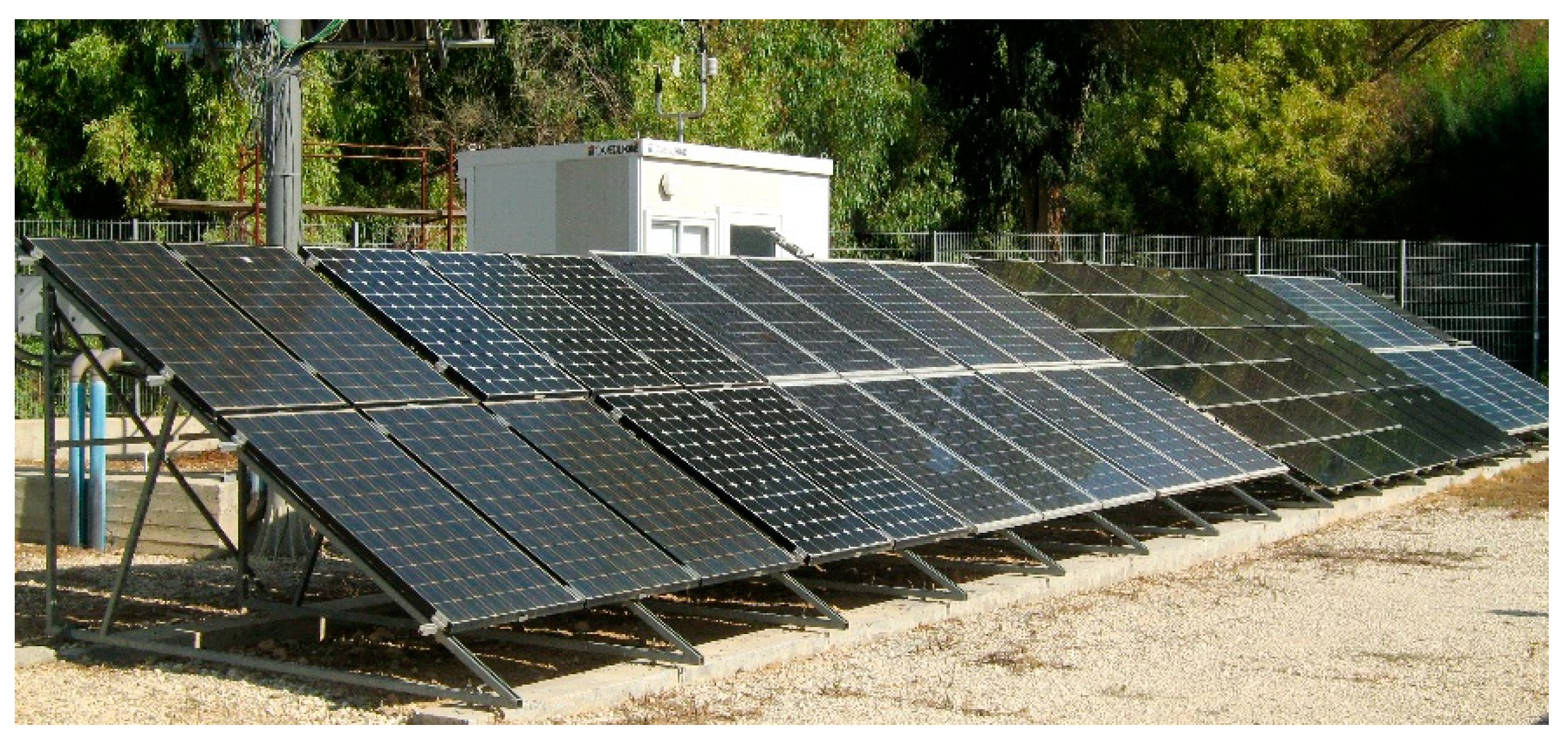
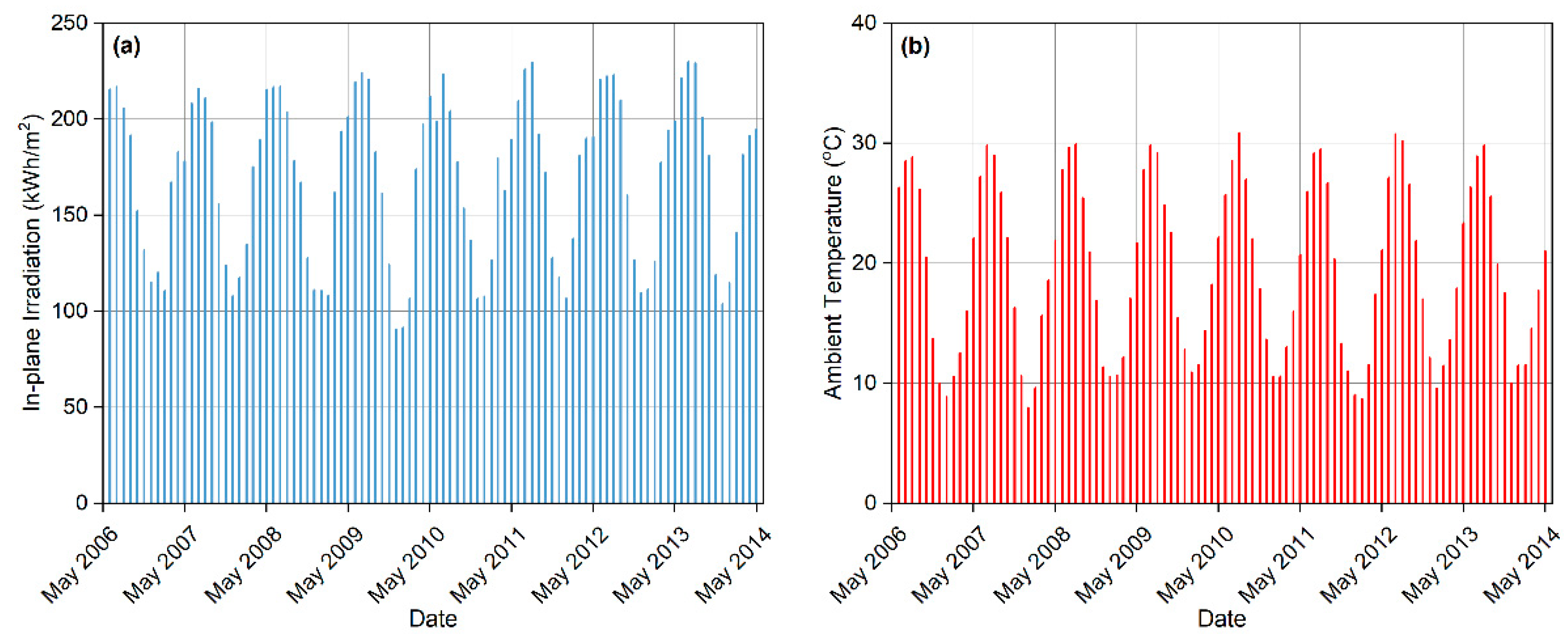
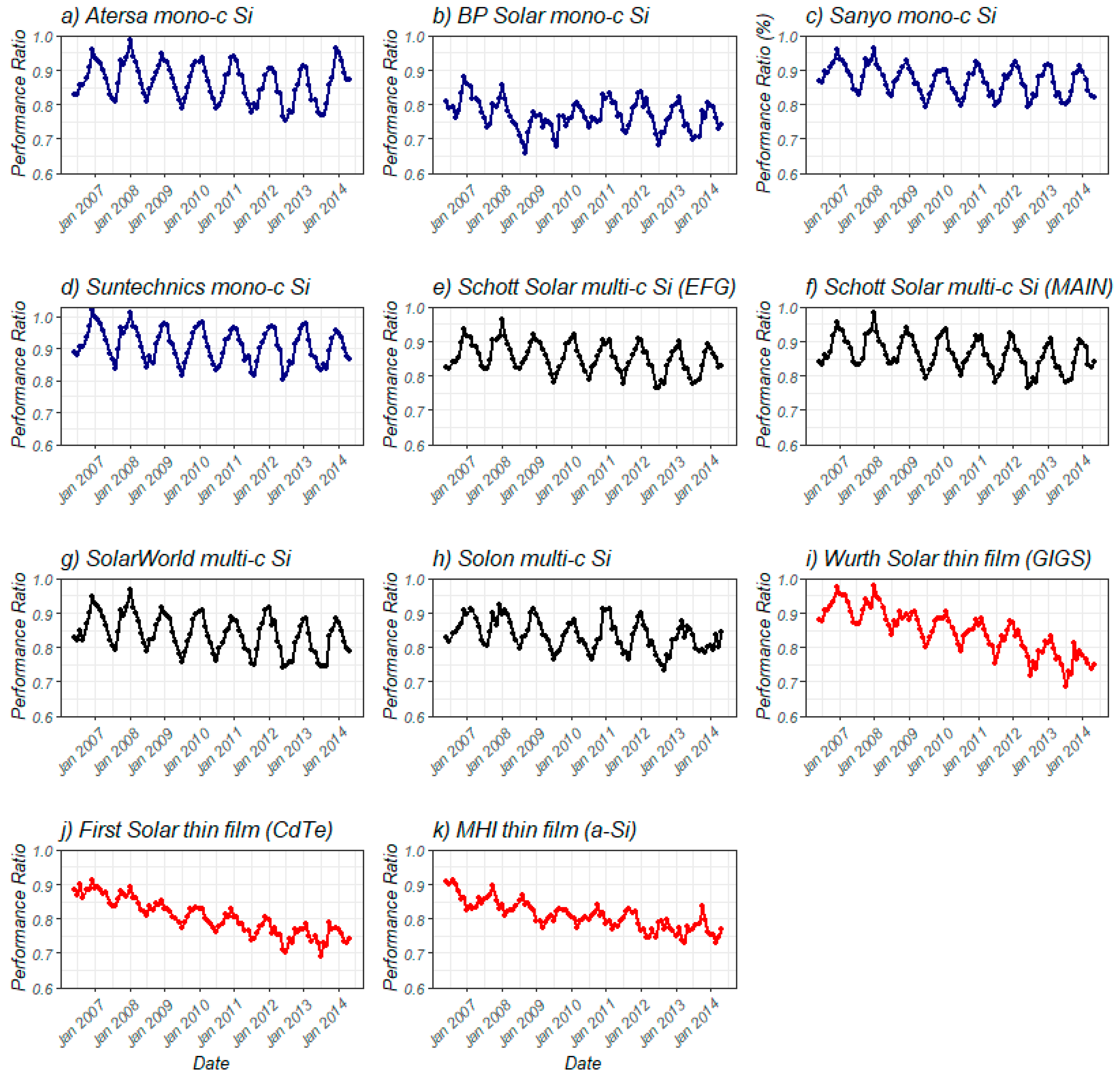
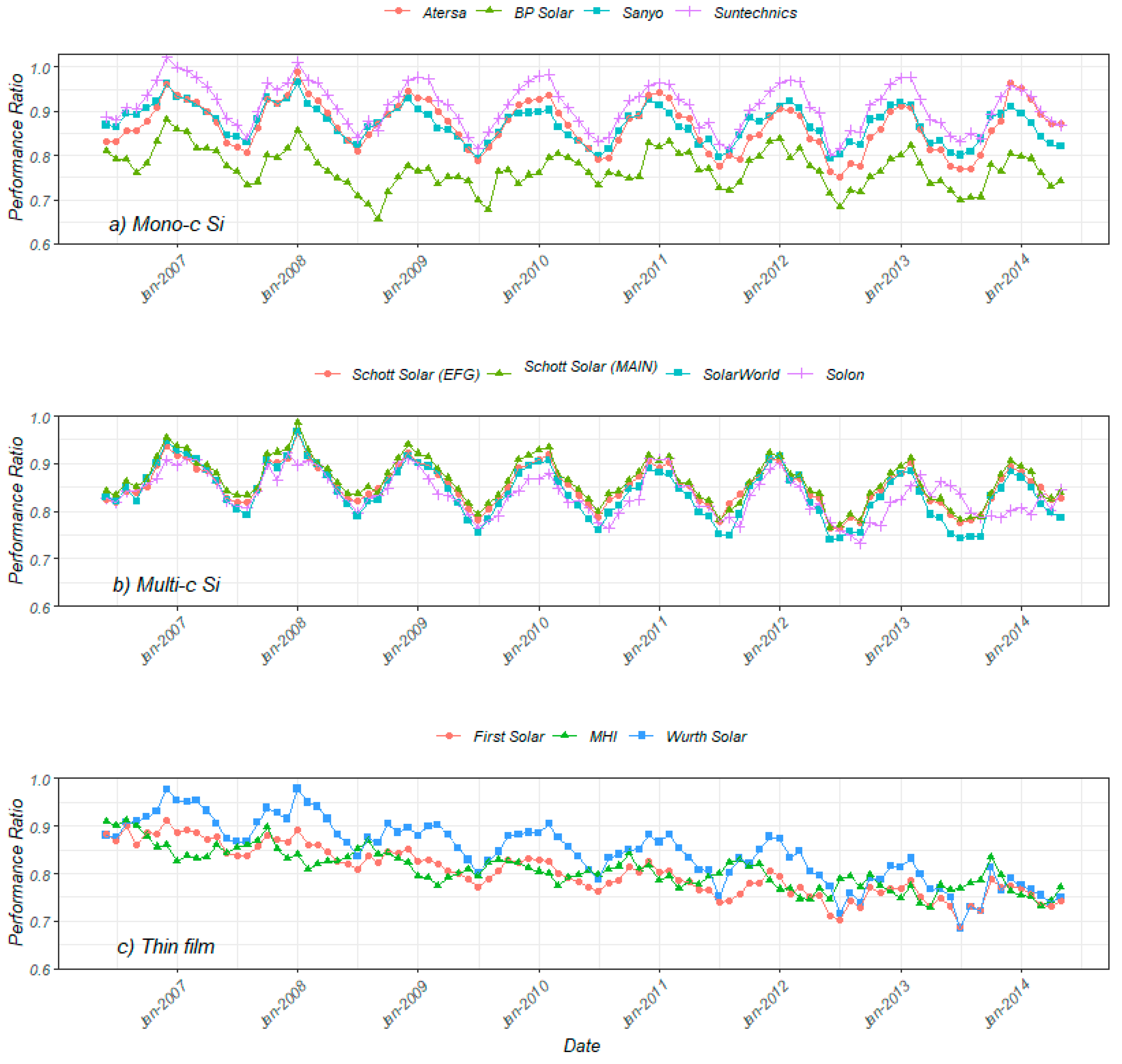
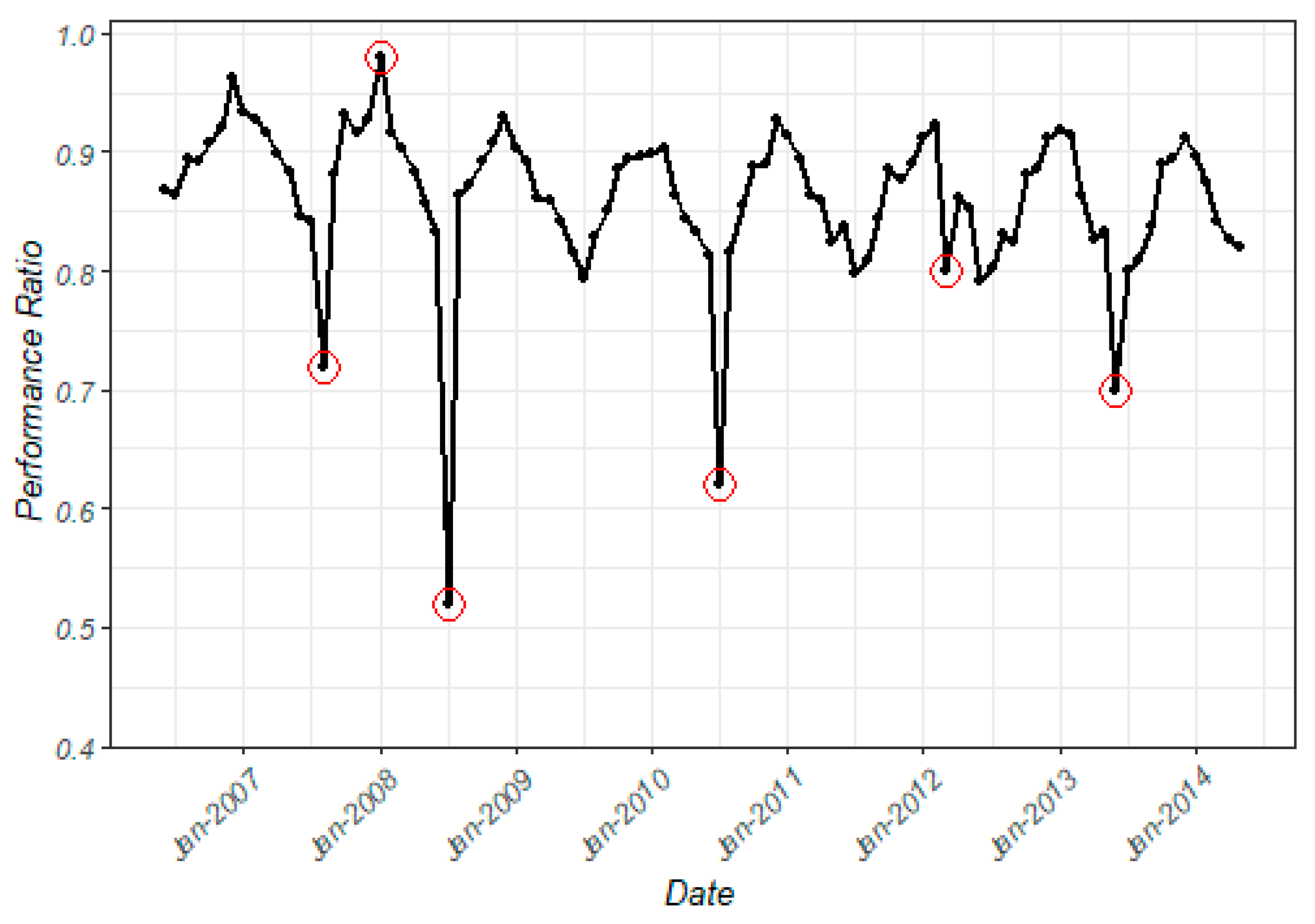
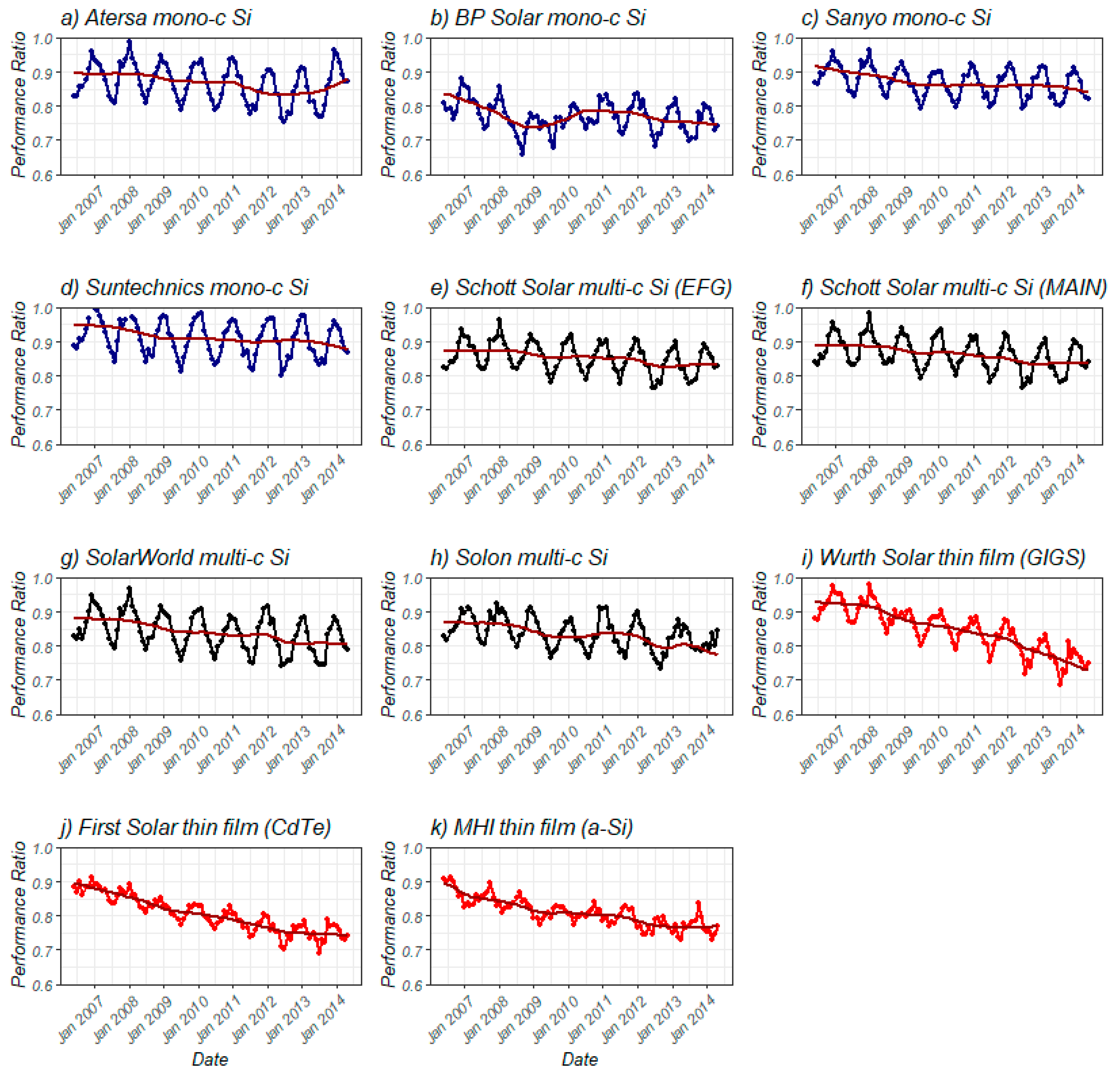
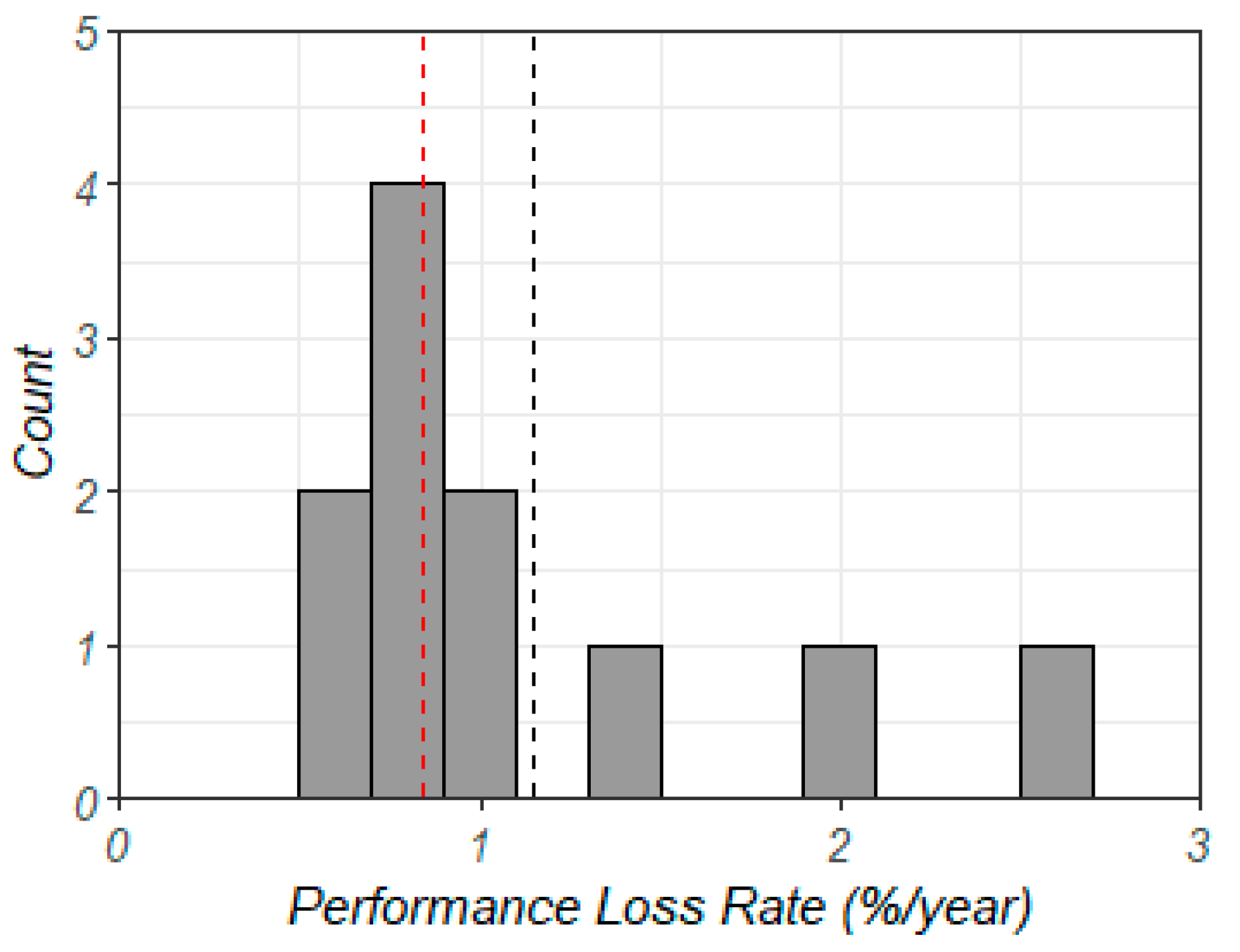
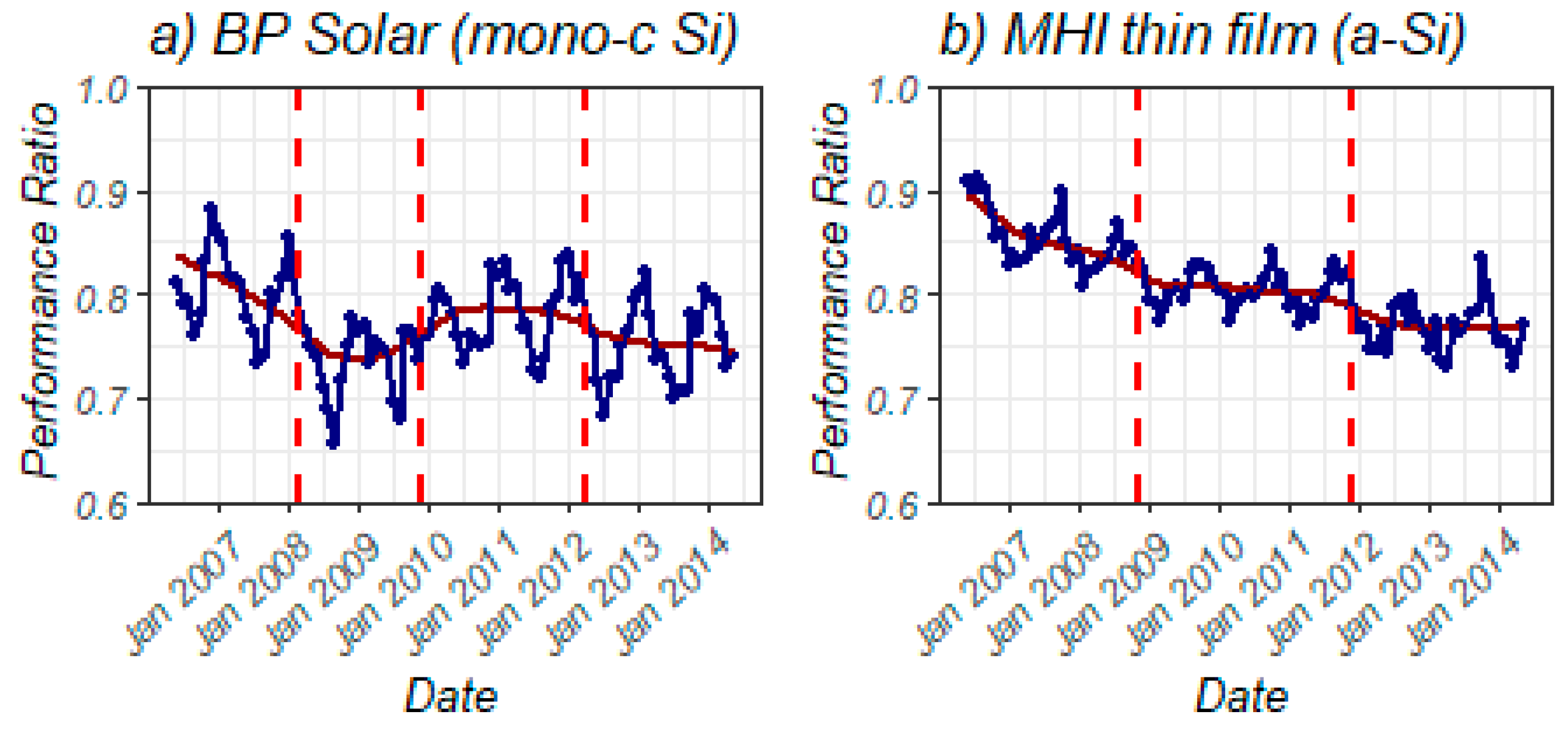
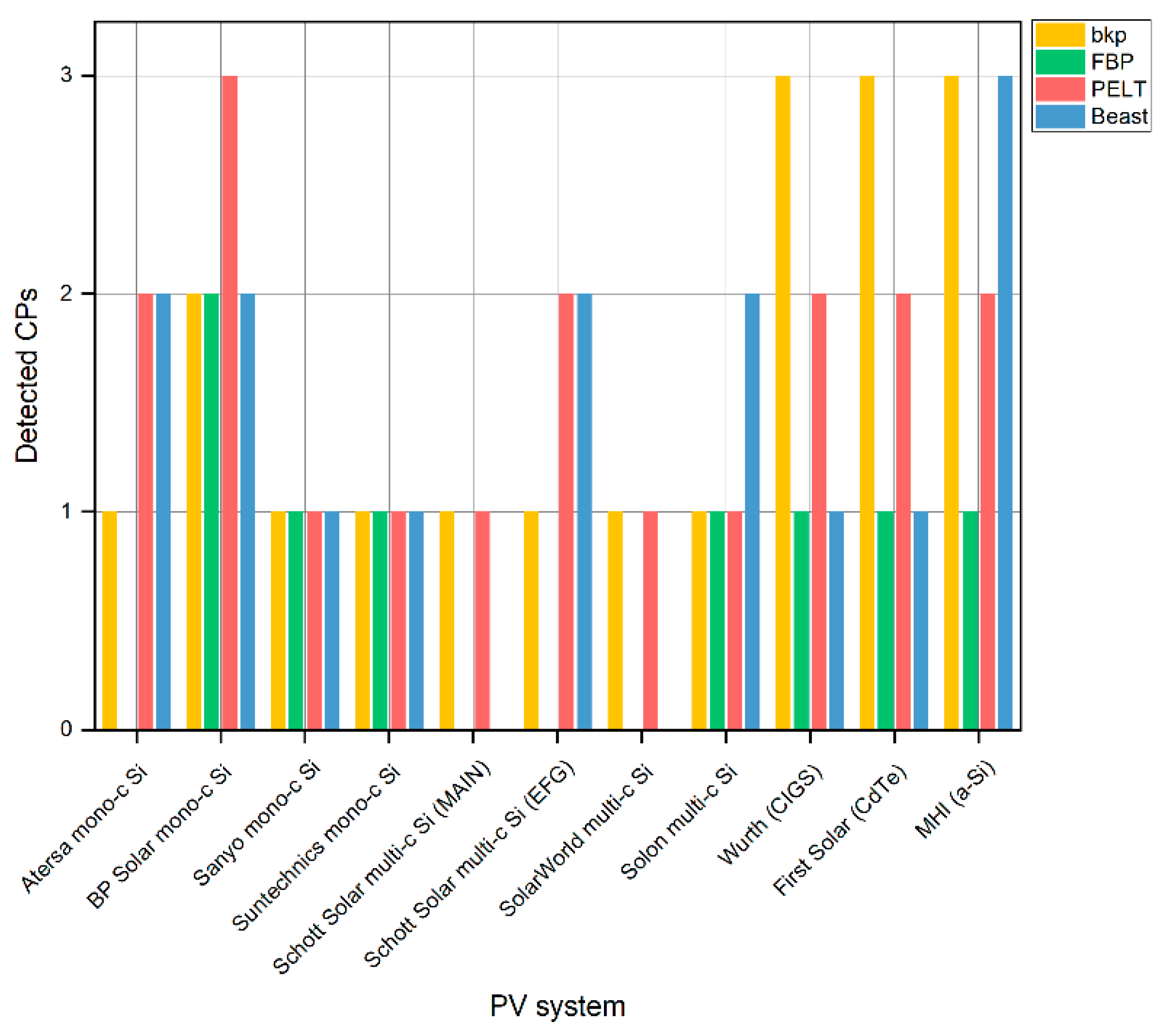
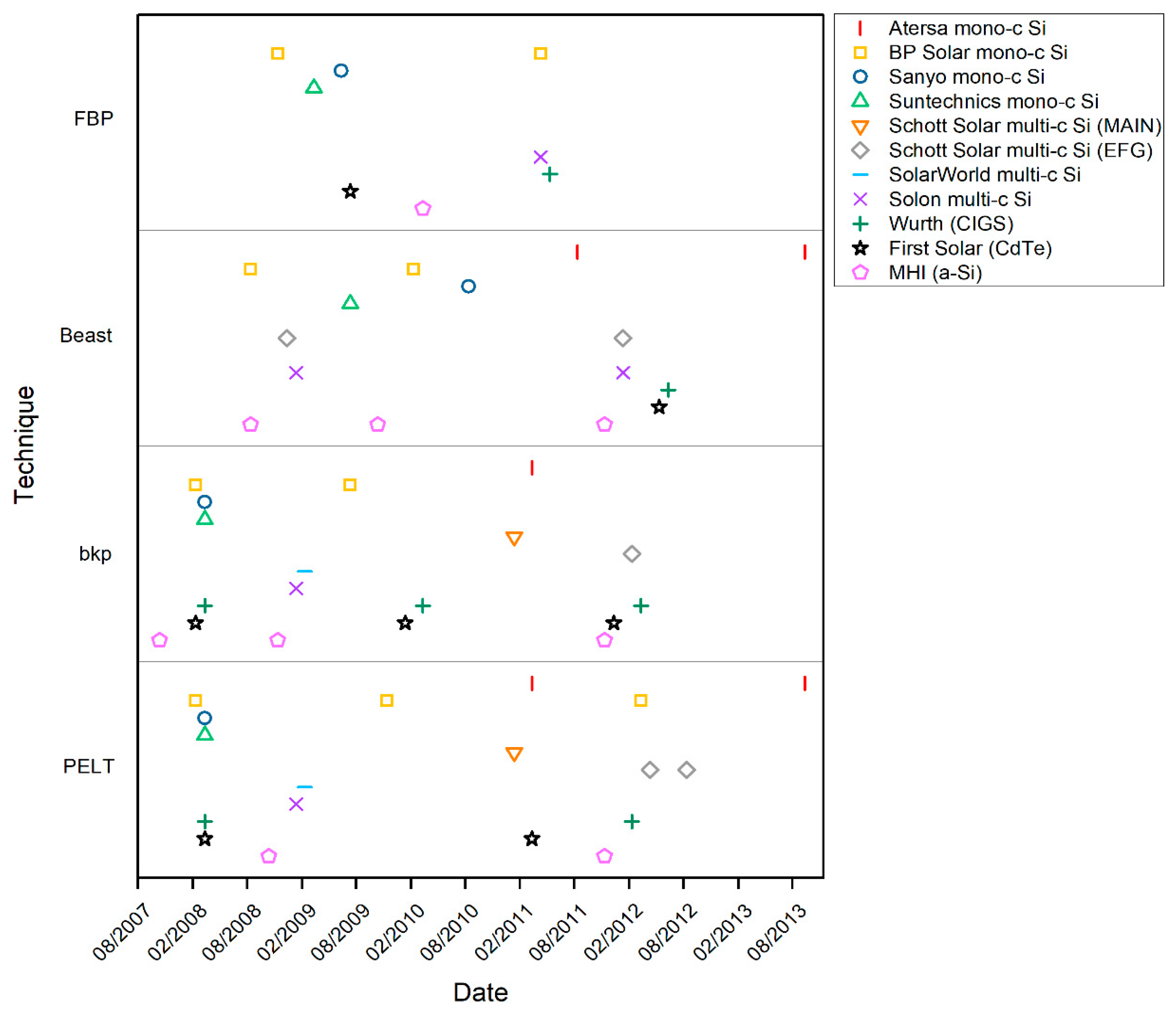
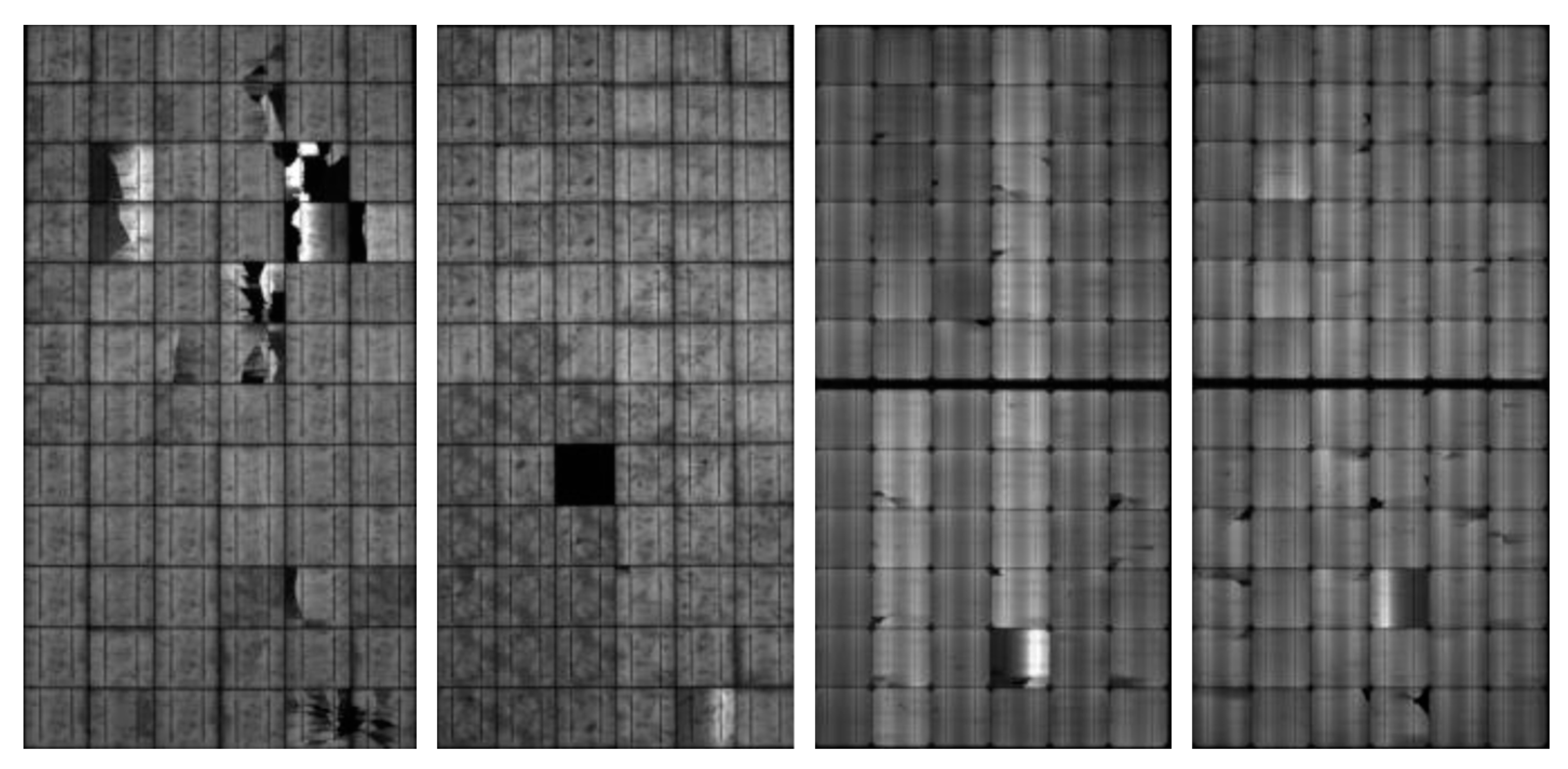
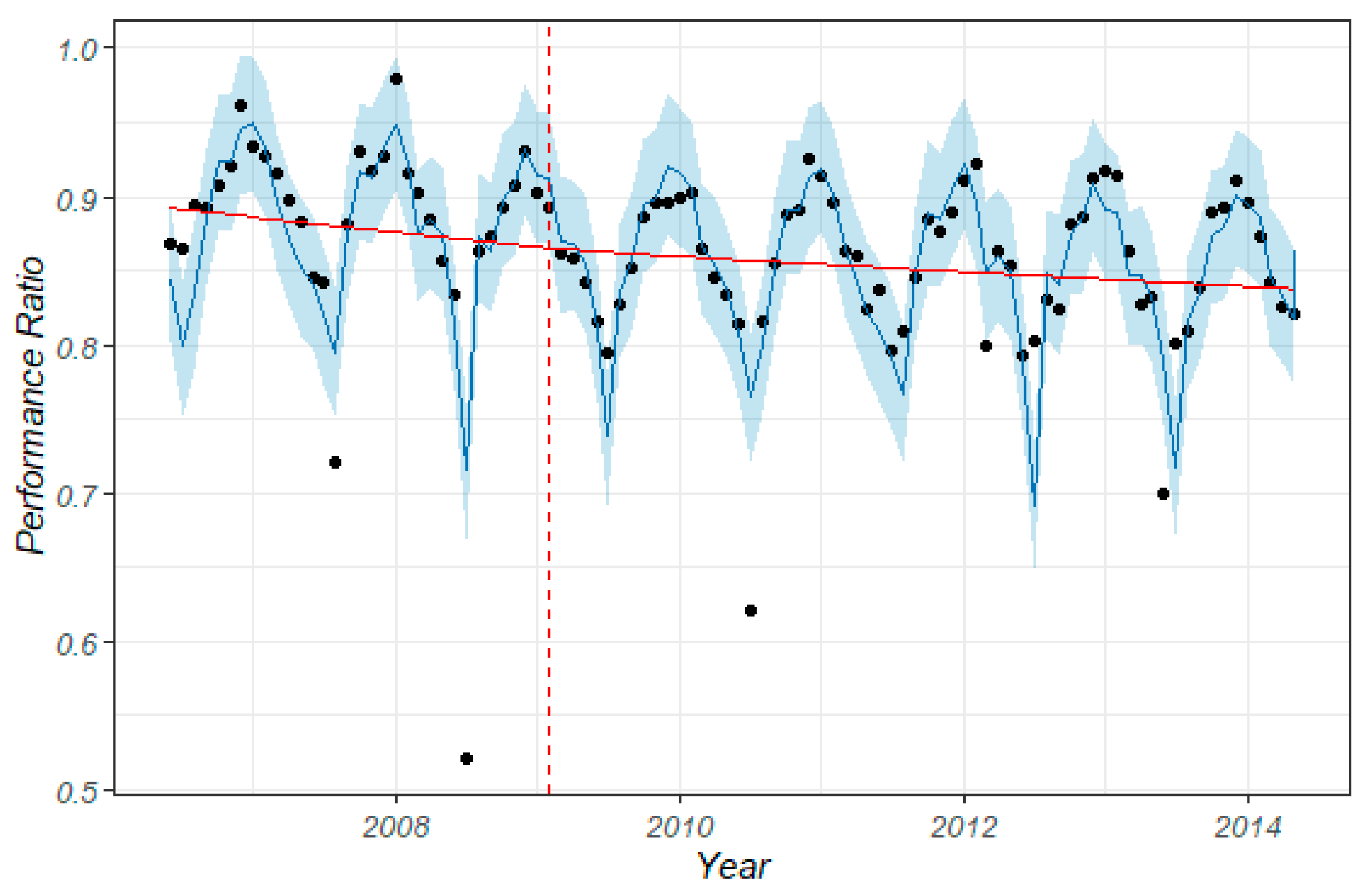
| System ID | Manufacturer | Technology | Series Modules | Parallel Module | Rated Power (kWp) |
|---|---|---|---|---|---|
| (a) | Atersa | mono-c Si | 6 | 1 | 1.020 |
| (b) | BP Solar | mono-c Si | 6 | 1 | 1.110 |
| (c) | Sanyo | mono-c Si | 5 | 1 | 1.025 |
| (d) | Suntechnics | mono-c Si | 5 | 1 | 1.000 |
| (e) | Schott Solar | multi-c Si (edge defined film-fed growth—EFG) | 6 | 1 | 1.000 |
| (f) | Schott Solar | multi-c Si (multi-crystalline advanced industrial cells—MAIN) | 4 | 1 | 1.020 |
| (g) | SolarWorld | multi-c Si | 6 | 1 | 0.990 |
| (h) | Solon | multi-c Si | 7 | 1 | 1.540 |
| (i) | Würth Solar | thin film (CIGS) | 6 | 2 | 0.900 |
| (j) | First Solar | thin film (CdTe) | 3 | 6 | 1.080 |
| (k) | Mitsubishi Heavy Industries (MHI) | thin film (a-Si) | 2 | 5 | 1.000 |
| Parameter | Manufacturer Model | Accuracy |
|---|---|---|
| Ambient temperature | Rotronic HC2A-S3 | ±0.1 °C at 23 °C |
| In-plane irradiance | Kipp Zonen CMP11 | ±2% expected daily accuracy, ±20 W/m2 for 1000 W/m2 |
| DC voltage | Muller Ziegler Ugt | ±0.5% |
| DC current | Muller Ziegler Igt | ±0.5% |
| AC energy | Muller Ziegler EZW | ±1% |
| System ID | Annual PLR (%/Year) ± Standard Error |
|---|---|
| (a) | −0.78 ± 0.00 |
| (b) | −0.60 ± 0.01 |
| (c) | −0.74 ± 0.00 |
| (d) | −0.75 ± 0.00 |
| (e) | −0.84 ± 0.00 |
| (f) | −0.68 ± 0.00 |
| (g) | −1.09 ± 0.00 |
| (h) | −1.09 ± 0.00 |
| (i) | −2.52 ± 0.03 |
| (j) | −2.04 ± 0.00 |
| (k) | −1.46 ± 0.00 |
| System ID | Number of CPs | Location of CPs |
|---|---|---|
| (a) | 2 | 04/2011, 10/2013 |
| (b) | 3 | 03/2008, 12/2009, 04/2012 |
| (c) | 1 | 04/2008 |
| (d) | 1 | 04/2008 |
| (e) | 1 | 02/2011 |
| (f) | 2 | 05/2012, 09/2012 |
| (g) | 1 | 03/2009 |
| (h) | 1 | 02/2009 |
| (i) | 2 | 04/2008, 03/2012 |
| (j) | 2 | 04/2008, 04/2011 |
| (k) | 2 | 11/2008, 12/2011 |
| System ID | Number of CPs | Location of CPs |
|---|---|---|
| (a) | 1 | 04/2011 |
| (b) | 2 | 03/2008, 08/2009 |
| (c) | 1 | 04/2008 |
| (d) | 1 | 04/2008 |
| (e) | 1 | 02/2011 |
| (f) | 1 | 03/2012 |
| (g) | 1 | 03/2009 |
| (h) | 1 | 02/2009 |
| (i) | 3 | 04/2008, 04/2010, 04/2012 |
| (j) | 3 | 03/2008, 02/2010, 01/2012 |
| (k) | 3 | 10/2007, 12/2008, 12/2011 |
| System ID | Number of CPs | Location of CPs |
|---|---|---|
| (a) | 2 | 09/2011, 10/2013 |
| (b) | 2 | 09/2008, 03/2010 |
| (c) | 1 | 09/2010 |
| (d) | 1 | 08/2009 |
| (e) | 0 | - |
| (f) | 2 | 01/2009, 02/2012 |
| (g) | 0 | - |
| (h) | 2 | 02/2009, 02/2012 |
| (i) | 1 | 07/2012 |
| (j) | 1 | 06/2012 |
| (k) | 3 | 09/2008, 11/2009, 12/2011 |
| System ID | Number of CPs | Location of CPs |
|---|---|---|
| (a) | 0 | - |
| (b) | 2 | 12/2008, 05/2011 |
| (c) | 1 | 07/2009 |
| (d) | 1 | 04/2009 |
| (e) | 0 | - |
| (f) | 0 | - |
| (g) | 0 | - |
| (h) | 1 | 05/2011 |
| (i) | 1 | 06/2011 |
| (j) | 1 | 08/2009 |
| (k) | 1 | 04/2010 |
| System ID | Linear FPB | FPB PLR1 | FPB PLR2 | FPB PLR3 |
|---|---|---|---|---|
| (a) | −0.83 ± 0.01 | - | - | - |
| (b) | - | −4.27 ± 0.01 | −2.49 ± 0.01 | −1.42 ± 0.01 |
| (c) | - | −1.35 ± 0.01 | −0.45 ± 0.01 | - |
| (d) | - | −1.07 ± 0.00 | −0.61 ± 0.00 | - |
| (e) | −0.96 ± 0.00 | - | - | - |
| (f) | −0.80 ± 0.00 | - | - | - |
| (g) | −1.23 ± 0.00 | - | - | - |
| (h) | - | −1.21 ± 0.01 | −0.90 ± 0.01 | - |
| (i) | - | −2.52 ± 0.00 | −2.66 ± 0.01 | - |
| (j) | - | −2.80 ± 0.00 | −1.99 ± 0.04 | - |
| (k) | - | −1.78 ± 0.01 | −1.48 ± 0.00 | - |
Disclaimer/Publisher’s Note: The statements, opinions and data contained in all publications are solely those of the individual author(s) and contributor(s) and not of MDPI and/or the editor(s). MDPI and/or the editor(s) disclaim responsibility for any injury to people or property resulting from any ideas, methods, instructions or products referred to in the content. |
© 2023 by the authors. Licensee MDPI, Basel, Switzerland. This article is an open access article distributed under the terms and conditions of the Creative Commons Attribution (CC BY) license (https://creativecommons.org/licenses/by/4.0/).
Share and Cite
Livera, A.; Tziolis, G.; Theristis, M.; Stein, J.S.; Georghiou, G.E. Estimating the Performance Loss Rate of Photovoltaic Systems Using Time Series Change Point Analysis. Energies 2023, 16, 3724. https://doi.org/10.3390/en16093724
Livera A, Tziolis G, Theristis M, Stein JS, Georghiou GE. Estimating the Performance Loss Rate of Photovoltaic Systems Using Time Series Change Point Analysis. Energies. 2023; 16(9):3724. https://doi.org/10.3390/en16093724
Chicago/Turabian StyleLivera, Andreas, Georgios Tziolis, Marios Theristis, Joshua S. Stein, and George E. Georghiou. 2023. "Estimating the Performance Loss Rate of Photovoltaic Systems Using Time Series Change Point Analysis" Energies 16, no. 9: 3724. https://doi.org/10.3390/en16093724
APA StyleLivera, A., Tziolis, G., Theristis, M., Stein, J. S., & Georghiou, G. E. (2023). Estimating the Performance Loss Rate of Photovoltaic Systems Using Time Series Change Point Analysis. Energies, 16(9), 3724. https://doi.org/10.3390/en16093724








